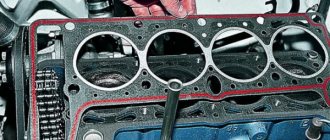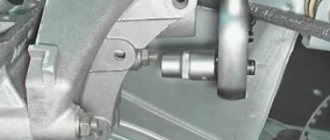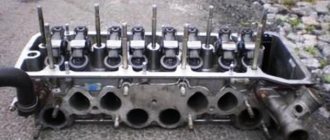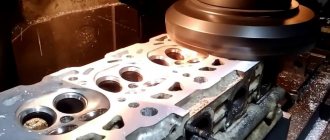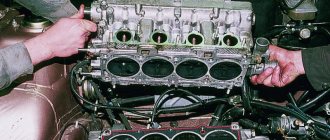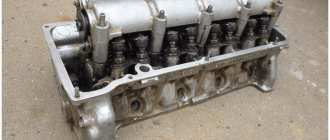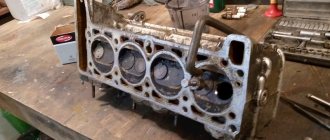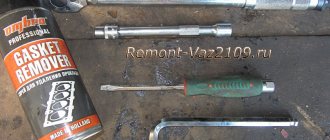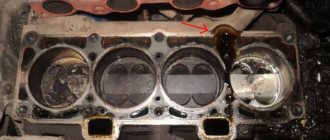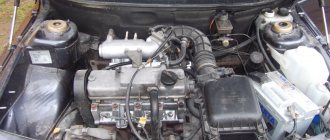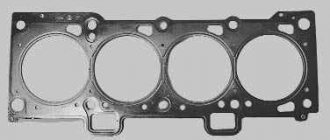According to many years of experience of various car enthusiasts, replacing the cylinder head of a VAZ 2109 is most often associated with problems arising with the gasket. But there may be others that can cause the engine to overheat or even seize.
Every driver can repair and modify the cylinder head on a VAZ 2109, but special tools and a little knowledge of the operating principle of this unit are required. Recently, tuning of this unit has become increasingly popular, due to which the power of the car increases. Carrying out tuning yourself is possible if you have experience in such work. Working with valves and actuators requires specialized knowledge and skills.
When is it time to change?
- When replacing or repairing a cylinder head, you may begin to notice that fuel consumption has increased or the unit's power has decreased.
- Also, improper assembly and installation of valves and cylinders can lead to malfunctions in the cylinder head system.
- If you constantly fill your car with low-quality gasoline, do not be surprised that over time this system will begin to malfunction and will require repairs.
- The resulting crack in the block cannot be repaired except by completely replacing the element.
- A sign of a problem in the cylinder head may be white smoke coming from the exhaust pipe, caused by coolant entering the engine cylinders.
- If there are oil stains on the surface of the coolant in the tank, the unit requires repair. This is due to the fact that the oil somehow began to get where it shouldn’t.
- It is rare, but it happens that exhaust gases begin to penetrate through the gasket. In this case, there is no other option but to remove the head and replace the gasket.
- For VAZ 2109 tuning, restoration, problems with spark plugs, forging bolts or boring cylinders, disassembling the cylinder head may be required.
White smoke from the exhaust pipe
Reinstalling the head
Now you can carefully install the cylinder head in its place, making sure that at this moment the gasket does not slip out or move to the side. Of course, the guides fix it, but you should still be extremely careful.
Next, we will need a torque wrench, since the bolts will have to be tightened with a certain torque. It is also worth keeping in mind that the tightening order must be observed. The diagram below shows the sequence in which to twist:
Now regarding the force with which it is necessary to tighten the bolts. This should be done in 4 steps:
- First, a torque of 20 Nm
- Second reception with a torque of 75-85 Nm
- Tighten each bolt another 90 degrees.
- Finally turn it 90 degrees.
After this, all that remains is to install all the equipment removed from the car, fill in the coolant, connect all the sensors, wires and hoses and check the work done. Usually everything becomes visible immediately after pouring antifreeze. If wet marks appear at the junction of the head and block, you can take everything back and do the whole job again! But I hope that this will not happen in your practice! Happy renovation!
Process
Before you begin disassembling and repairing the VAZ 2109 cylinder head, it is necessary to perform certain preparatory work in sequence.
Removal
- First of all, remove the air purifier housing.
- Disconnect the hoses and lines from the carburetor or injector.
- After this, you need to disconnect the pants from the manifold.
- Remove the grinding wheel.
- Unscrew the valve cover.
- Remove the carburetor and manifolds.
- To unscrew the head bolts on a VAZ 2109, most likely you will need a gate and a hexagon, since the screws are screwed in with decent force. Tube as a lever
- Remove the cylinder head bolts and washers.
- We remove the VAZ 2109 cylinder head from the power unit.
- Remove the gasket. A gasket that has reached the end of its life and needs to be replaced.
- In addition, if necessary, engine block components are repaired or modified.
The pipe is like a lever.
Remove the screws.
A gasket that has reached the end of its service life must be replaced.
Tuning
Proper adjustment, modification and tuning of the VAZ 2109 head will help to fully reveal the capabilities of your power unit. You've probably heard about it, read a lot, or even watched videos on the Internet. Typically tuning is done by boring and aligning the bores, which reduces turbulence and reduces power. The valves were replaced with larger ones and ground into their seats. Tuning may also include replacing the standard valve guides with bronze ones.
Valve lapping
The following is a check of the running-in process:
- the assembled head is on its side;
- the collector holes are filled with liquid (ordinary water can be used).
If fluid does not leak through the valves, the job is done well and the valves are lapped properly. After eliminating all defects, you can proceed to assembling the head.
What is a cylinder head
The cylinder head on a VAZ 2109 in a disassembled state.
The VAZ 2109 cylinder head is a special unit whose main purpose is to close the cylinders. It is attached directly to the block itself using special bolts. The cylinder head is important because it is a direct participant in numerous processes during engine operation. The cylinder heads of power units of cars produced today are distinguished by a rather complex structure and are assembled from a significant number of parts.
Ridiculous cases
If the engine seizes, signs of thickened oil may indicate sugar entering the system. Similar consequences occur when stirring a raw egg, which, when the motor is running, will certainly heat up and weld all the channels. How the latter substance enters the system is known only to the owner of the car.
Sugar can be poured into the fuel by ill-wishers through the refueling hatch. There are many substances that change the composition of the oil. It happens that a driver may mistakenly pour a mixture that is lethal to iron into the engine neck.
A malfunction where coolant penetrates into the oil can also lead to jamming of the rubbing metals. This can be noticed when measuring the level using the dipstick. The changed composition is noticeable to the eye and to the touch: by color, viscosity, and the presence of foam. A whitish tint indicates a loss of oil quality.
Tightening the cylinder head and running-in config
The time has come to assemble the engine and the question arose about completing the attachment. Since the engine is new, I had to run it gently for 2000 km at a speed of no more than 3000. I could install all the tuning parts at once (Stingger trapezoid receiver, 56mm throttle, Volga injectors, DBP/DTV and possibly the camshaft) but then I would have to immediately make adjustments to firmware, but there was no desire to do it (as well as the opportunity). And the engine would have lost in the low end, but there would be no way to break it in without them.
Therefore, I decided to assemble it from stock for testing, although of course it is clear that the factory receiver and the sawn head are a so-so combination
